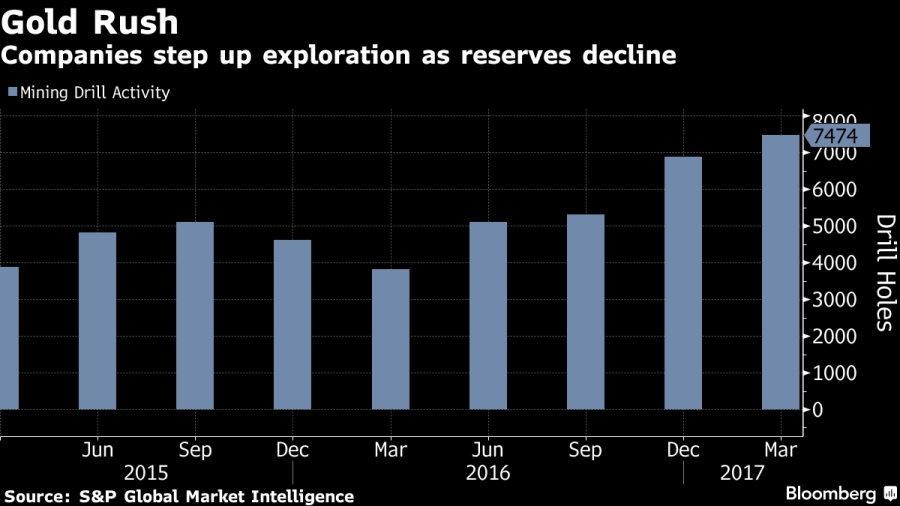From Yukon to Patagonia, gold explorers stir after sleep
by Danielle Bochove
From Canada's Yukon to southern Patagonia, outbreaks of gold-rush fever are popping up as bullion markets stage a tentative recovery.
The number of holes drilled at gold deposits has been rising steadily for more than a year, according to S&P Global Market Intelligence. And while early-stage exploration budgets haven't kept pace with spending at existing mines, prospecting hot spots are starting to pop up in traditional destinations Canada, Australia and Latin America.


In some parts of Argentina, exploration has jumped about 50 percent, mainly for lithium but also for gold in provinces such as Santa Cruz, according to state-controlled energy company YPF SA. Chile's government also sees a pickup this year with prospectors focusing on both copper and gold. Colombia is also attracting more attention.
Drilling successes are adding to the interest. Aurion Resources Ltd. shares have more than tripled since Feb. 1 when it announced a discovery in northern Finland, while SolGold Plc has risen 12-fold in the past year as it drilled out a copper and gold find in Ecuador. This week's $431 million deal between Eldorado Gold Corp. and Integra Gold Corp. is the latest acquisition driven by a need to secure new ounces.
"We need more exploration in the industry; it's been such a long downturn," Mark Ferguson, head of mining studies at S&P Global Market Intelligence, said in a phone interview from Halifax, Nova Scotia. "A lot of producers are going to start facing medium-term shortfalls in their pipeline if they're not replacing the reserves that they're actively mining."
Richest Pockets
Producers cut project spending as prices retreated from a 2011 peak, focusing instead on reducing debt and tapping the richest pockets of gold in their mines for the lowest possible costs.
As prices fell toward $1,000 an ounce in 2015, the World Gold Council warned that the industry was nearing "peak gold," after which output would begin to fall for the first time since 2008. Ferguson believes output still has room to creep higher this year and next but says it's inevitable that by 2019, the legacy of years of reduced exploration and capital spending will be falling global supply.
Still, he expects producers will continue to tread cautiously while addressing shrinking production pipelines, with exploration budgets only marginally higher in 2017, at best. The spike in global gold drilling activity was helped by last year's surge in prices above $1,300. But with this year's average closer to $1,234, the industry has yet to see a sustained surge in exploration financing.
"We have a good month in financing and then we have just an OK month," Ferguson said. "In my mind there are a lot of questions in terms of how sustainable the investment is, and how that's going to translate into budgets."


With competition for exploration dollars still stiff, countries with weak exchange rates have an advantage. And Canada, even though it's a mature mining market, remains under-explored given its lack of infrastructure.
"The North still remains one of those frontiers for mining," Eira Thomas, renowned Canadian geologist and prospector said in a recent interview. "Places like Yukon, the Northwest Territories and Nunavut will continue to attract exploration dollars going forward as the market for commodities hopefully improves."
Buying Growth
Thomas was chief executive officer of Kaminak Gold Corp. last year when it was snapped up by Goldcorp for just over $400 million. Vancouver-based Goldcorp made the acquisition to access Kaminak's Coffee deposit south of the Dawson City in Yukon.
Since then, rivals Barrick Gold Corp. and Newmont Mining Corp. have acquired exploration stakes in the Yukon, as has Agnico Eagle Mines Ltd. Although these are comparatively small, all three companies are seeking to replenish their pipelines through a combination of fresh exploration and spending at existing operations.
On Thursday, Kinross Gold Corp. made a new move in the Yukon, selling its interest in White Gold Corp.'s exploration project in exchange for a 19.9 percent stake in the explorer and cash. The transaction put Kinross on par with Agnico, which also controls 19.9 percent of White Gold.
In February, Agnico also announced a plan to invest more than $1.2 billion in Nunavut, in Canada's subarctic, to build a new mine and expand another. Newmont is moving forward with a $300 million expansion of its Ahafo operation in Ghana. The company's 2017 budget for greenfield and brownfield exploration is stable at $200 million.
Barrick has been selling stakes in existing mines, in part to fund development of assets elsewhere, including along the Argentina-Chile border. Its development budget rose more than 45 percent in 2017 to a range of $185 million to $225 million.
The company is "agnostic" as to whether new ounces come from greenfield, near mine, brownfield or partnerships, Kelvin Dushnisky, Barrick's president, said in an email. "We allocate our dollars to the best opportunities."